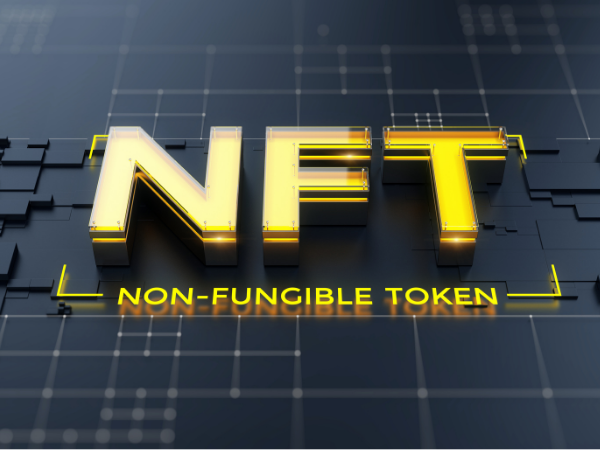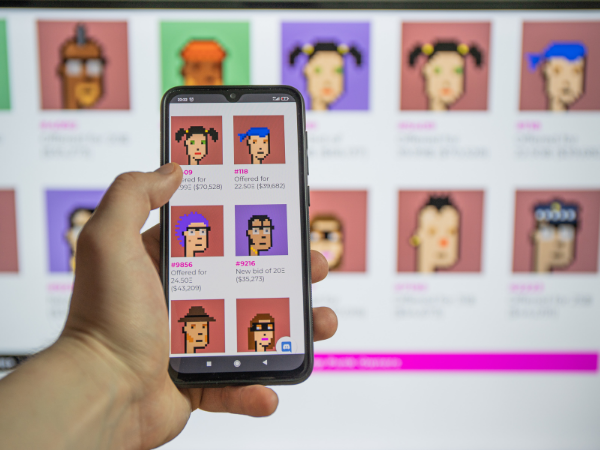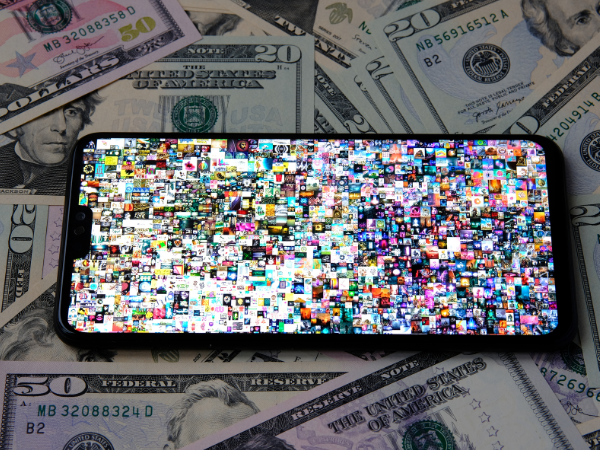How to create NFT art and enter a whole new art world!
Believe it or not, learning how to create NFT art takes only a few minutes. Numerous NFT marketplaces can help you, but they all work similarly. Let’s go through the steps, from minting to selling your first NFT artwork!
Before we talk about those, we will first explain what non-fungible tokens are. Then, we will explain the upsides and downsides of turning pieces of art into NFTs. Of course, we will show how your masterpiece can turn into an NFT!
You may have noticed the cryptocurrency trend spreading across the globe. Yet, it’s changing various industries and fields, specifically the art world. By learning how to create NFT art, you are making sure your works join this digital revolution.
What are non-fungible tokens (NFTs)?

Have you ever seen the Mona Lisa? Many people have likely never seen it themselves at The Louvre. Yet, you probably saw countless pictures floating around on the internet.
Of course, the original piece is still more valuable than those digital replicas. But what if you could own a unique electronic copy of this iconic art piece?
This is how a non-fungible token or NFT works. A blockchain or cryptocurrency network registers your ownership of a specific art piece.
It won’t matter if there are millions of duplicates out there, and yours is special because it’s tied to the blockchain. However, this isn’t the reason it caught the world’s attention.
On March 11, 2021, Mike Winkelmann, a.k.a. “Beeple,” made the first-ever digital art sold as an NFT. It was “Everydays: The First 5000 Days”, and it sold for $69,346,250!
As a result, more digital artists wanted to know how to create NFT art. It took on other forms as well. For example, Filipino music producer Mark Redito made the Natural Habitat NFT album.
NFTs spread in the world of movies too. Anthony Hopkins’ latest flick, “Zero Contact,” will premiere as an NFT on Vuele. non-fungible tokens even took more unusual forms.
Twitter CEO Jack Dorsey sold his first-ever tweet as an NFT. It sold for $2,915,835.47. The world of NFTs is truly full of possibilities!
Related Article: What’s the Next Bitcoin?
Should I turn my art into NFTs?
Before you learn how to create NFT art, you must see its good and bad sides. We were already raving about it, so let’s start with its pros:
- Digital artists own their work – It’s hard to claim ownership of digital art when people can easily make copies. Turning it into an NFT helps you keep ownership. They could copy the art, but not its registration on a blockchain.
- Helps artists earn income – Artists deserve compensation for their work just like any other professional, and NFTs make this easier by letting a crypto network process its earnings. What’s more, artists could also earn royalties from NFT art.
- Show your art to the world – NFTs are popular nowadays. That’s why many art enthusiasts worldwide gather in NFT marketplaces. Turning your art into an NFT lets more people see it in the art world.
Now, let’s turn to the bad side of NFTs. Every medium has its flaws, and it’s up to you to use the ones that fit your goals. Let’s go through the issues of NFTs one by one:
- Data hosting and storage – Your NFT depends on a blockchain, and if that breaks, so will your NFT art.
- Royalties – We know we covered royalties as a perk by NFTs. However, those rely on your NFT platform, and if people don’t buy it from there, you won’t be earning royalties.
- Security – Blockchains are highly secure but not foolproof. If someone takes your NFT account, the artworks in it are up for grabs.
- Intellectual property – This is by far the biggest problem artists have with non-fungible tokens. Others could claim your work as an NFT, and if that happens, you’ll have to dispute their claim.
- Cost – Minting an NFT costs gas fees expressed as Ethereum (ETH), which are notoriously high. For example, a person was shocked when charged $80 to convert his wrapped Ethereum or WETH coins into regular Ethereum.
Read More: What Are Non-fungible Tokens Or NFTs?
How do I make NFT art?
There are many ways you can create this type of art. Several platforms like Nifty Gateway let people buy and sell NFTs, and each one has a different way of creating or “minting” them.
Your choice will determine your NFT experience. You may choose two types of NFT marketplaces. Read below for more details:
- Curated platforms – Think of these as “NFT art museums, and they only allow high-quality work from authorized artists. If you’re just starting, these might not be for you.
- Self-service platforms – These let anyone create and publish NFTs. You may also use any medium, which means you can have NFTs with images, videos, or even sound files.
Yet, they work similarly. That’s why we could show steps on how to create NFT art. Let’s take a closer look below:
- Choose an NFT marketplace – Pick from the two types of marketplaces we mentioned. Then, find options that fit the category.
- Get a digital wallet – This is an app that stores cryptos and NFTs. The Ethereum blockchain is the most commonly used network for NFTs. This means you should load up your wallet with its cryptocurrency called Ethers (ETH). Then, you should connect your wallet to your NFT account.
- Create your collection – Now, it’s time to make your masterpiece. Perhaps you’ll use Adobe Photoshop or MS Paint? It’s up to you. We can show you how to create NFT art, but you have to make the “art” part!
- Create digital arts tokens – Click on Add New Item or the similar button on your chosen NFT marketplace. Then, fill out metadata to help buyers know more about your NFT art. You should also determine the cryptos you’ll accept as payment. Afterward, click Create or the similar button on your platform.
- List your art for sale – You may offer a fixed price for your work. If not, you could put it up for auction. This is where you’ll have to pay gas fees.
Final thoughts
Creating and selling your digital art is one thing, and promoting it is another. Make sure everyone knows about your NFT art—spread the word about it on social media.
Of course, your digital asset deserves far more than this, and other artists will use social media platforms too. Make sure you have a competitive edge.
That’s where LeadAdvisors can help. This digital marketing company can aid in promoting your NFT art. Click here to learn more.
Related Articles
Learn more about how to create NFT art
How do I turn my art into NFT?
First, register at an NFT marketplace and get a digital wallet. Then, create your digital art piece as an image, video, song, or another medium. Next, turn it into a digital art token and fill out the necessary details. Finally, list your art piece for sale in the marketplace.
What is the most expensive NFT ever sold?
On March 11, 2021, Mike Winkelmann became the first person who created an NFT artwork. Winkelmann named it “Everydays: The First 5000 Days” and sold the NFT artwork for $69,346,250. At the time of writing, this was the most expensive piece. Note that someone might have made a pricier NFT by the time you’re reading this.
Is it hard to sell NFT art?
It’s challenging to sell anything in general, especially NFT art. Contrary to popular belief, your product or service won’t sell itself. You will have to work hard to promote it to the right audience. This is especially true for NFT art because most people don’t know much about NFTs or cryptocurrencies.
Sponsored Advertising Content:
Advertorial or Sponsorship User published Content does not represent the views of the Company or any individual associated with the Company, and we do not control this Content. In no event shall you represent or suggest, directly or indirectly, the Company's endorsement of user published Content.
The company does not vouch for the accuracy or credibility of any user published Content on our Website and does not take any responsibility or assume any liability for any actions you may take as a result of reading user published Content on our Website.
Through your use of the Website and Services, you may be exposed to Content that you may find offensive, objectionable, harmful, inaccurate, or deceptive.
By using our Website, you assume all associated risks.This Website contains hyperlinks to other websites controlled by third parties. These links are provided solely as a convenience to you and do not imply endorsement by the Company of, or any affiliation with, or endorsement by, the owner of the linked website.
Company is not responsible for the contents or use of any linked website, or any consequence of making the link.
This content is provided by New Start Advantage LLC through a licensed media partnership with Inquirer.net. Inquirer.net does not endorse or verify partner content. All information is for educational purposes only and does not constitute financial advice. Offers and terms may change without notice.



